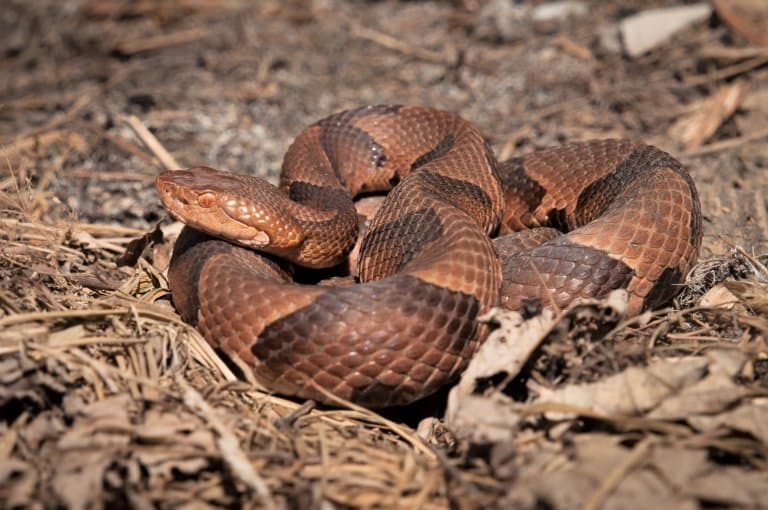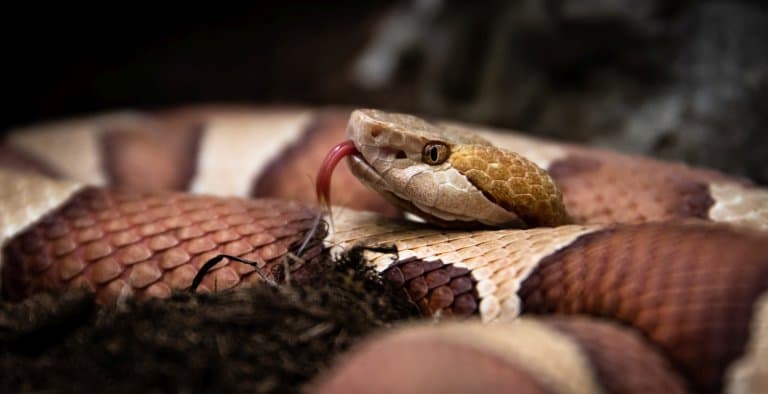Eastern Copperhead Profile
There are some classic venomous snakes from North America, many of which are notoriously venomous, and this notoriety is no doubt fuelled in part by the American sensitivity to danger.
Among them are the pit vipers: snakes like the Diamondback, the Cottonmouth, and today’s subject: the Eastern Copperhead.
These snakes are light reddish-brown in color, with distinctive dark brown hour-glass markings overlaid. They can grow to over 1m in length and live in forests and woodlands of America and Mexico.

Eastern Copperhead Facts Overview
| Habitat: | Forests, rocky outcrops and swamps |
| Location: | North America |
| Lifespan: | 18 years |
| Size: | 50 – 130cm |
| Weight: | Up to around 2kg |
| Colour: | Dark, woody brown with a dappled pattern |
| Diet: | Rodents, birds, lizards, frogs |
| Predators: | Humans |
| Top Speed: | Slow |
| No. of Species: | 1 (5 subspecies) |
| Conservation Status: | Least Concern (IUCN) |
Eastern Copperheads are widespread throughout the US and Mexico. They’re infamous for their nasty bite, something which is likely less dangerous than most people expect.
Still, they pack a punch, and unlike some species, are prone to getting stepped on due to their reliance on exceptional camouflage.
They have a generalist diet and will feed on a variety of prey, including insects, as well as rodents, birds, lizards and frogs.
These are populous and adaptable snakes that inhabit a range of environments and are successful predators and breeders in their ecosystem.
They have some really cool adaptations, and for the most part, they’re of low conservation concern.
Interesting Eastern Copperhead Facts
1. Their camouflage is dangerous
Copperheads are ambush predators, using their leaf-like patterned body as perfect cover among the leaf litter in the forest.
Unfortunately for both the snake and the people who step on them, this camouflage does lead to some painful interactions.
While most snakes will flee at the sound of an approaching human, copperheads are very confident in their ability to blend in, which ends up working too well in cases where ramblers are bitten on the ankle.

2. They’re also comfortable in the hood
But these snakes don’t only hide in the forest. They’re cosmopolitan predators from a wide range of habitats.
Up in the mountains, they occupy cliff faces and rocky outcrops and in the more humid and subtropical regions, they can even be found navigating swamps.
As cities expand and develop, copperheads stay put and are often now found in suburbia, around many large cities in the US. 1
3. Their venom can be dangerous
While the copperhead is the most dangerous snake in many states, it’s far from the most lethal. Still, it’s not a snake that anybody would enjoy being bitten by.
Many bites are what’s called ‘dry’ bites, which are simply defensive attacks designed to frighten off a threat without wasting any precious venom. In these instances, symptoms may be minimal, but if given a dose of a copperhead’s blood-damaging venom, things can get a bit ugly.
Swelling and pain are a given, but in some cases, blisters, bruises and tissue necrosis can occur. If the bite is on an extremity, that digit might have to be amputated, but otherwise, the conditions are usually survivable, just unpleasant 2
4. Copperheads account for half of the treated snake bites in the US
Over 7,000 people get bitten by snakes each year in America.
Fortunately, the number of venomous snake bites is much lower, at around 100 each year – of which only 5-10 are fatal.
Research has shown that Copperhead snakes account for approximately half of treated snakebites in the US. 3
5. They can use a lure
Copperheads aren’t very aggressive and are generally avoidable. But they’re born with some interesting talents. Not only are the new hatchlings fully venomous on birth, and equipped with the hardware to inject it with, they’re natural trappers.
Young copperheads will have a bright tip to their tail, which they can use as a lure to attract small mammals or frogs. Lying in wait, they’ll ambush a curious passer-by and are able to hunt effectively in their first year of life this way.
They also use this wiggle as adults, a way of showing defensive intentions when disturbed. 4
6. And face pits
As a pit viper, these snakes are named after a sixth sense that stems from pits in their snouts.
Inside these pits are special membranes that respond to infrared light; light radiated from the bodies of a nocturnal animal, for example.
Several types of nocturnal hunting snakes use these IR goggles to navigate the forest at night, able to see their prey in total darkness from up to a meter away.
And copperheads, as ambush predators, can lie in wait acting like an infrared camera, able to snatch prey out of the darkness to eat.
7. Facultative parthenogenesis
Not everything has to have sex to reproduce. Bananas, for example, just clone themselves. If you snap off a branch of a bay tree and stick it in the ground, you’ll have two bay trees.
But this weird quirk of nature isn’t limited to plants. Animals can achieve some version of this in various forms, and copperheads are one example.
Cloning is not an ideal way to reproduce; if all your offspring have the same exact genetic makeup as you, they’re all vulnerable to the same single pathogen or environmental shift. It’s better to spread your genes out and mix them around so there’s a natural variation down the line.
However, sometimes it’s hard to hook up, and copperhead snakes use it as a backup when the mate quality just isn’t quite there.
It’s not entirely understood why this happens, but the female snake seems to be able to switch between sexual and asexual reproductive strategies, and if they aren’t happy with the sexual options, they can self-fertilise their own eggs. 5

8. They’re doing okay, but still need protection
Their reproductive flexibility probably has a fair bit to do with why these snakes are so successful. And while they do cause pain and damage, they rarely kill people, so in most places, they tend to be left alone.
Globally, their populations are considered stable and they’re listed as of least concern by the IUCN.
However, they are persecuted in some areas, and road deaths are common, which has led to their status as a conservation concern and subsequent state protection in Iowa, Massachusetts and New Jersey. 6
Eastern Copperhead Fact-File Summary
Scientific Classification
| Kingdom: | Animalia |
| Phylum: | Chordata |
| Class: | Reptilia |
| Order: | Squamata |
| Family: | Viperidae |
| Genus: | Agkistrodon |
| Species: | Agkistrodon Contortrix |
Fact Sources & References
- Ben Biggs (2022), “Copperhead snakes: Facts, bites & babies”, Live Science.
- Alix Thorson M.D (2003), “Copperhead Envenomations In The Carolinas”, Taylor & Francis Online.
- Michael E. Mullins et al. (2019), “Thromboelastometry (ROTEM) and thromboelastography (TEG) in copperhead snakebites: a case series“, Clinical Toxicology.
- A “Copperhead Caudal Lure”, Youtube.
- Warren Booth (2012), “Facultative parthenogenesis discovered in wild vertebrates”, NIH.
- “Agkistrodon contortrix”, IUCN.
